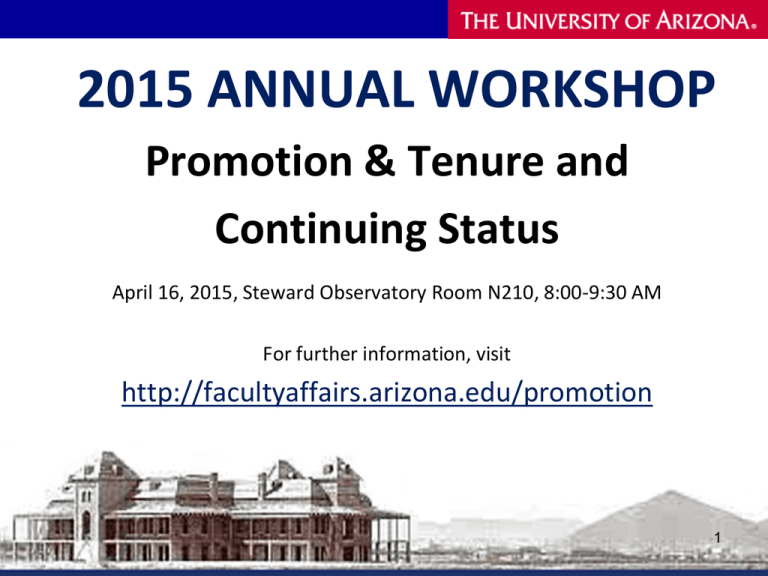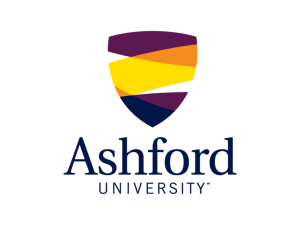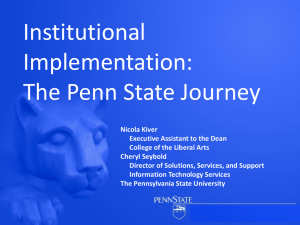2015 ANNUAL WORKSHOP Promotion & Tenure and Continuing Status
advertisement

2015 ANNUAL WORKSHOP Promotion & Tenure and Continuing Status April 16, 2015, Steward Observatory Room N210, 8:00-9:30 AM For further information, visit http://facultyaffairs.arizona.edu/promotion 1 Agenda Introductions Preparing for Promotion Reviews Overview of Changes to Promotion Dossiers The Promotion Review Process Peer Reviews of Teaching Student Evaluations of Teaching Distinctive Aspects of Continuing-Status Reviews 2 Introductions • George Frantziskonis, Co-Chair, P&T Committee • Wayne Brent, Assoc. Director, Evaluation Services, OIRPS • Thomas Miller, Vice Provost for Faculty Affairs 3 The Promotion Process Starts Where the Hiring Process Ends Department Heads Should • Use annual reviews to help candidates set goals. • Help candidates prioritize service commitments. • Help limit new teaching preparations and align teaching and research interests. • Specify criteria and expectations. • Be precise on areas needing improvement. • Help candidates articulate their goals and needs. • Keep good records. 4 Candidates Should • Review and discuss promotion criteria. • Share your writing with colleagues. • Talk to senior faculty about how they assess impact, national standing, and quality. • Keep an eye out for external reviewers. • Use annual reviews to Discuss your program of work, Set limits and priorities, and Solicit frank assessments. • Solicit peer review / classroom observations 5 Requesting Delays in Reviews Submit requests at least one semester before the review. 1. Birth or Adoption 2. Personal Reasons such personal health or family and partner care 3. Adverse Professional Circumstances that are beyond a candidate’s control 4. Prestigious External Commitments that take time away from research 6 Promotion and Tenure Reviews University P&T Committee Co-chair George Frantziskonis, Department of Civil Engineering 7 Protect the Process to Ensure Fair Reviews • • • • • • • Follow the P&T guidelines. Base decisions on stated criteria. Make sure formats are followed. Ensure external and internal reviewers are independent. Use Collaborator Letters from those who are not. Monitor the review process for fairness. Consult with your dean or the Provost’s Office on procedural variations or questions. • Have committee members sign and date letters. Explain votes, recusals and abstentions. 8 The Promotion Review Process External Reviews Department Committee/Department Head College Committee/College Dean University Committee/Provost Dossiers are due in the Provost’s Office January 15, 2016 Selecting External Reviewers Solicited by the Department Head or the Committee Chair—if they are not collaborators • • • • • • • • MUST be independent and above candidate’s rank. Only head or committee chair should contact reviewers. No more than half from candidate’s list. Document the selection process. Use the standard template for requesting letters. Include all solicited letters. Put external reviews before collaborator letters. Submit brief bios of external reviewers, not CVs. 10 The Promotion Dossier 1. 2. 3. 4. 5. 6. 7. 8. 9. Summary Data Sheet Candidate’s Workload Assignment Departmental and College CS&P Criteria (not full guide) Curriculum Vitae and List of Collaborators Candidate Statement Teaching Portfolio (added in 2013) Evaluation of Teaching: Separate letter on teaching required. Service and Outreach Portfolio (Optional in P&T Reviews) Membership in Graduate Interdisciplinary Programs Documentation for Interdisciplinary Candidates 10. Letters from Outside Evaluators and Collaborators 11. Recommendations from Internal Reviewers Refer to the Guide for tips on preparing dossiers 11 Section 2: Workload Assignment Prepared by the Department Head The Workload Assignment should be kept current and accurate • Use percentages and define meaning – 40% teaching, which means ... – 40% research, which means ... – 20% service, which means ... • Must be DESCRIPTIVE, not evaluative. • Use the template provided in the dossier. • Electronic signatures are acceptable. 12 Sections 4 & 5: Documenting and Discussing Your Achievements • Follow the required CV format exactly. • Get models for CVs and candidate statements. • Keep records of service and teaching contributions. • Use the Candidate Statement to Characterize your research and teaching goals, methods, and results; Connect with teaching and service dossiers; and Thereby demonstrate the impact of your work. 13 Representing Your Teaching in Your Candidate Statement • Goals: What do you try to help students learn, How do you help them learn it, and How do you assess their progress? Guiding Principles Learning Motivation Interpersonal dynamics • Methods: Curricular design Modes of instruction Context Management • Assessment and Impact: In-class student feedback Peer assessments TCE reports Letters from students Broader contributions 14 Section 6: The Teaching Portfolio • • • • • • • The Candidate Statement sets up the Portfolio. Instructional materials stay in the department. List all courses taught in period in rank. List the funded and pending awards and grants. Document advising and mentoring. Describe development activities. Provide your committee with full TCE forms, student comments, and the TCE summary sheet. • Only the TCE summary goes forward. 15 Section 7: Evaluating Teaching & Advising • A peer review letter on teaching is required in addition to the general department letter: • • • • Assess instructional materials. Include observation of teaching. Review student assessments of teaching. Discuss other instructional contributions. • Consult Peer Review of Teaching Protocol, which is available at http://oia.arizona.edu and now supports departmental templates. • Summarize TCE reports and obtain independent student comments. • Summary sheet for TCEs goes forward with dossier. 16 TCE Consultation and Support Services Assistance to faculty accessing and interpreting TCEs. Consultation with heads or committees on • Using ratings in annual and performance reviews and • Revising TCEs to assess curricula and student support. Contact: Wayne Brent, Associate Director, Evaluation Services Office of Instruction and Assessment wbrent@email.arizona.edu and 520-621-9488 17 What do TCEs Measure? • Student experiences, perceptions, feelings, selfreflections on their effort and learning, self assessment on performance and expected grade, self efficacy, etc • TCE’s can measure student’s perceptions of instructor and course effectiveness in support of their program completion and perceived learning. TCE’s Do NOT • measure student learning and grades Service and Outreach Portfolio • This section is an option for P&T candidates whose outreach and service is integral to their program of work. • This section is required for continuing status reviews that include educational outreach. • In P&T reviews, these materials remain in departments. • Consult our Inclusive View of Scholarship Resources • What to Include? Technical reports, research studies, and presentations Articles for popular publications and instructional materials, • What to include in the dossier to document impact? Letters from community collaborators noting impact Letters from university collaborators noting rigor and innovation News reports on service contributions Adoptions of programs and materials by other institutions 19 Additions to Dossiers? • Up to February 1, additions may be made (for example, a major grant or publication). • However, the addition must be requested by an administrator or committee chair. • Additions require re-review at earlier levels. • Candidate must be informed. • Candidate must be given chance to respond if the information is negative (such as poor teaching evaluations). 20 Appeals of Promotion Decisions • The Provost’s decision may be appealed, as detailed in UHAP 3.3.02.e and UHAP 4A.3.02. • Appeals to the President must be made in writing within 30 days of the Provost’s decision. • Access to redacted dossier is provided following the Provost’s Office protocol. The President’s decision is final, except in cases of discrimination or unconstitutional violations of due process. 21 How Do P&T and Continuing-Status Reviews Differ? • CS duties may not fit neatly into the categories of teaching, research & service. • Thus, the job description and allocation of time are even more important. • Work with your supervisor to align your duties with your unit’s guidelines for promotion, and • Make sure to document your contributions to publications and grants. • Finally, develop an assessment plan to demonstrate the impact of your activities. 22 Your Job Description Sets Your Baseline • Explain your contributions in non-technical terms • Include all job descriptions and note changes. • Often job descriptions include statements of duties that are used to assess position effectiveness. • Duties should be divided into four categories: Research/Scholarship/Creative Activity, Outreach/Service, Teaching/Educational Outreach, Program Development can be used to include administrative activities that may not otherwise be evaluated for CS&P. 23 Specify your Duties Accurately Workload areas CALS CALS Curator Librarian Researcher Research/scholarly/ creative activity 30% 10% 40% 10% 65% Classroom teaching Outreach education / 50% extension Program 20% Development Service 25% 70% 30% 20% 20% 80% 10% 10% 10% 24 Document Your Impact • Use the Candidate Statement and Service/Outreach Portfolio to discuss how your work affects others. • Specify what external reviewers need to understand. • Enlist outside reviewers who do related work. • Provide the brief bios to your head or committee chair. • Describe your relationship to them. • Discuss soliciting collaborator letters to document the impacts of your work. 25

